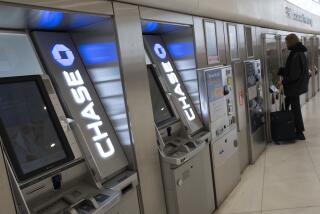Tougher capital rules proposed for 8 largest U.S. banks
WASHINGTON — The nation’s eight largest banks would have to meet tougher financial ratios than required under international standards as part of proposed rules designed to protect taxpayers from another financial crisis.
Under the plan, Bank of America Corp., JPMorgan Chase & Co., Citigroup Inc., Wells Fargo & Co. and four other U.S. bank holding companies designated as “systemically important financial institutions” would each have to hold capital equal to at least 5% of total assets.
In addition, their federally insured bank subsidiaries, such as Citibank and Chase bank, would have to hold capital equal to at least 6% of assets, according to the proposed rules.
Other U.S. banks and bank holding companies have to meet only a 3% leverage ratio under rules adopted by regulators as part of an international agreement known as Basel 3.
The extra capital for the largest banks is designed to protect the Federal Deposit Insurance Corp. fund that covers most deposits when an institution fails.
It also is designed to protect taxpayers who might be on the hook for losses if one of the largest banks has to be seized and dismantled by regulators to prevent damage to the financial system and the broader economy.
Some key Democratic and Republican lawmakers praised the proposal as helping address the problem of financial institutions considered too big to fail.
But American Bankers Assn. President Frank Keating criticized the plan. He said it would impose tougher regulations on large U.S. banks than faced by their European competitors and would make loans more difficult to obtain.
“Raising capital is not without cost. It means higher funding costs for loans and that fewer loans will be made,” Keating said.
Based on financial results as of Sept. 30, the eight bank holding companies would need to increase their capital by a combined $63 billion to meet a 5% leverage ratio, regulators said. The banking units of those companies would have to raise a combined $89 billion in capital to meet their proposed 6% leverage ratio.
Banks that don’t meet the new ratios would face restrictions on dividend payments, stock buybacks and executive bonus payments, according to the rules proposed by the FDIC, the Federal Reserve and the Office of the Comptroller of the Currency.
“Maintenance of a strong base of capital at the largest, most systemically important institutions is particularly important because capital shortfalls at these institutions can contribute to systemic distress and can have material adverse economic effects,” FDIC Chairman Martin J. Gruenberg said.
The proposal came as the FDIC board and the comptroller’s office also approved new rules on bank capital reserves adopted by the Fed last week.
Those rules, also part of the Basel 3 agreement, require all banks to hold more and higher-quality capital to absorb potential losses.
But in adopting those rules, Fed and FDIC officials said the new 3% international leverage ratio was not high enough for the eight systemically important U.S. banks.
FDIC Vice Chairman Thomas Hoenig felt so strongly about the need to boost the leverage ratio for those institutions that he voted Tuesday against approving the other rules because they did not include the proposed ratio increase.
He was the only member of the five-person FDIC board or the seven-member Fed Board of Governors to vote against the capital rules. The head of the comptroller’s office also approved the capital rules, which will be phased in by 2019.
The public has 60 days to comment on the proposed leverage ratio, which then would have to be approved by regulators. If approved, the new rules would take effect by Jan. 1, 2018.
“I support more and better capital,” Hoenig said at Tuesday’s FDIC board meeting. “However, the Basel 3 standard, without a binding leverage constraint, remains inadequate to the task of assuring the American public, who paid a high price for the financial crisis, that our capital standards are adequate to contribute to financial stability.”







